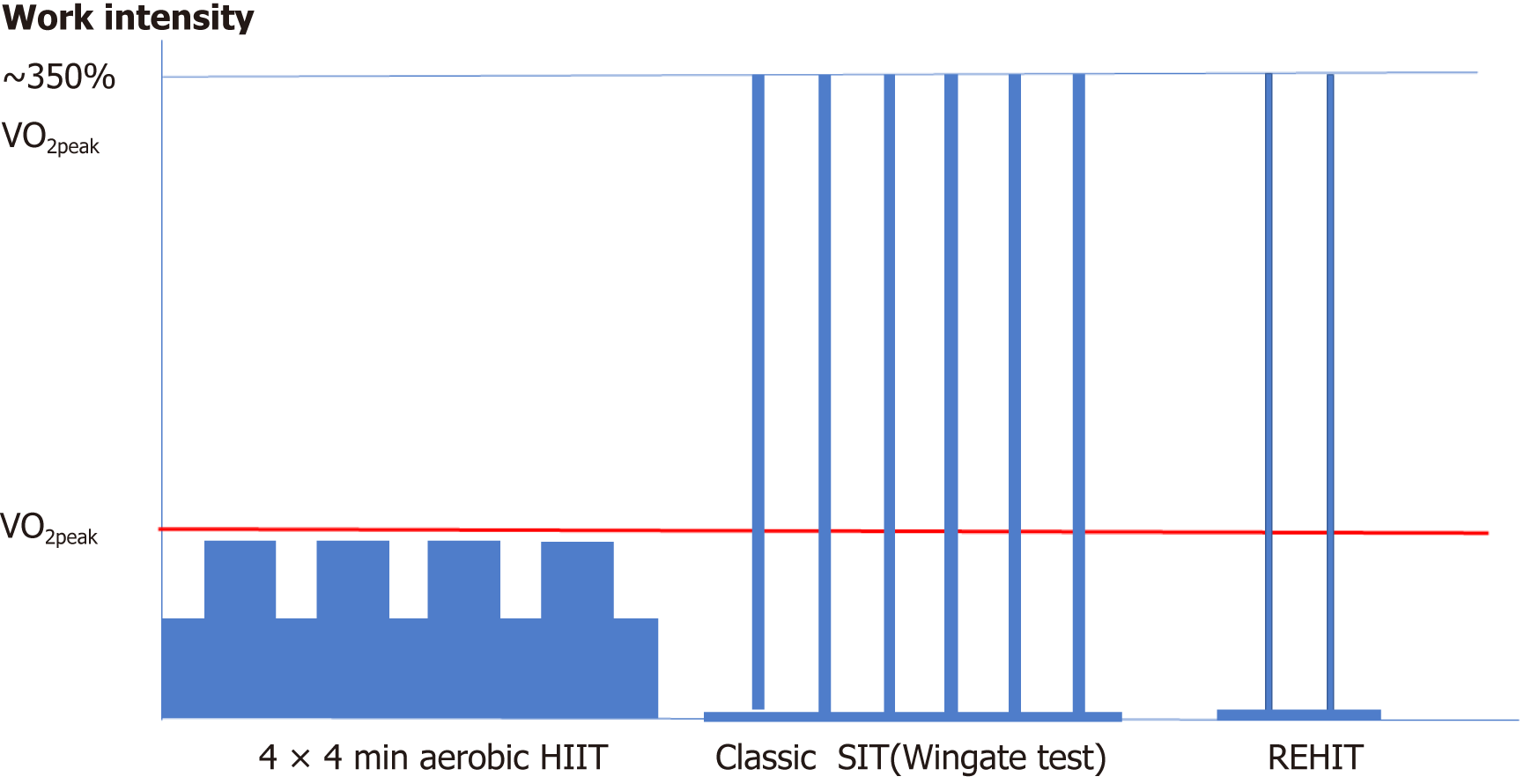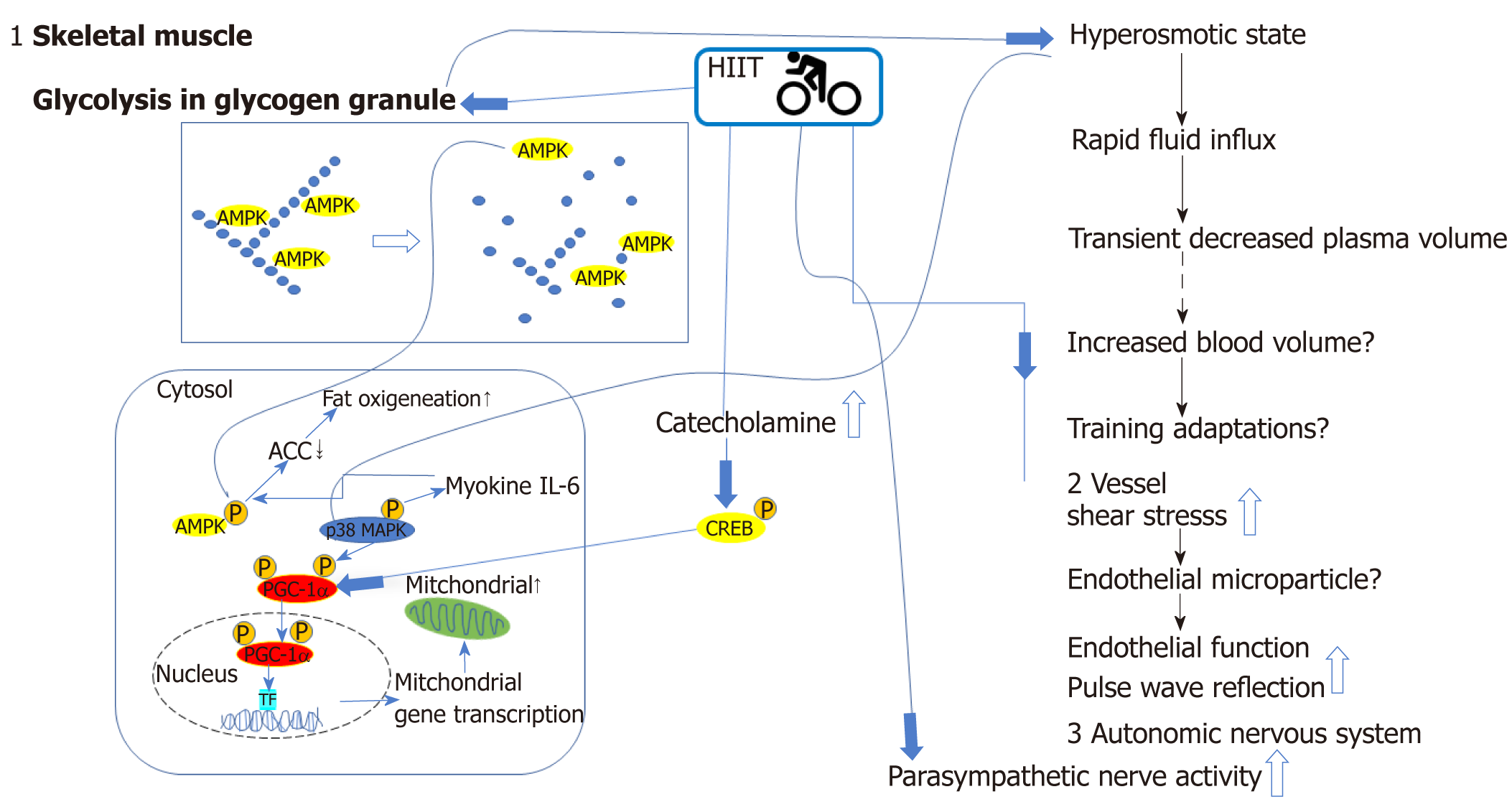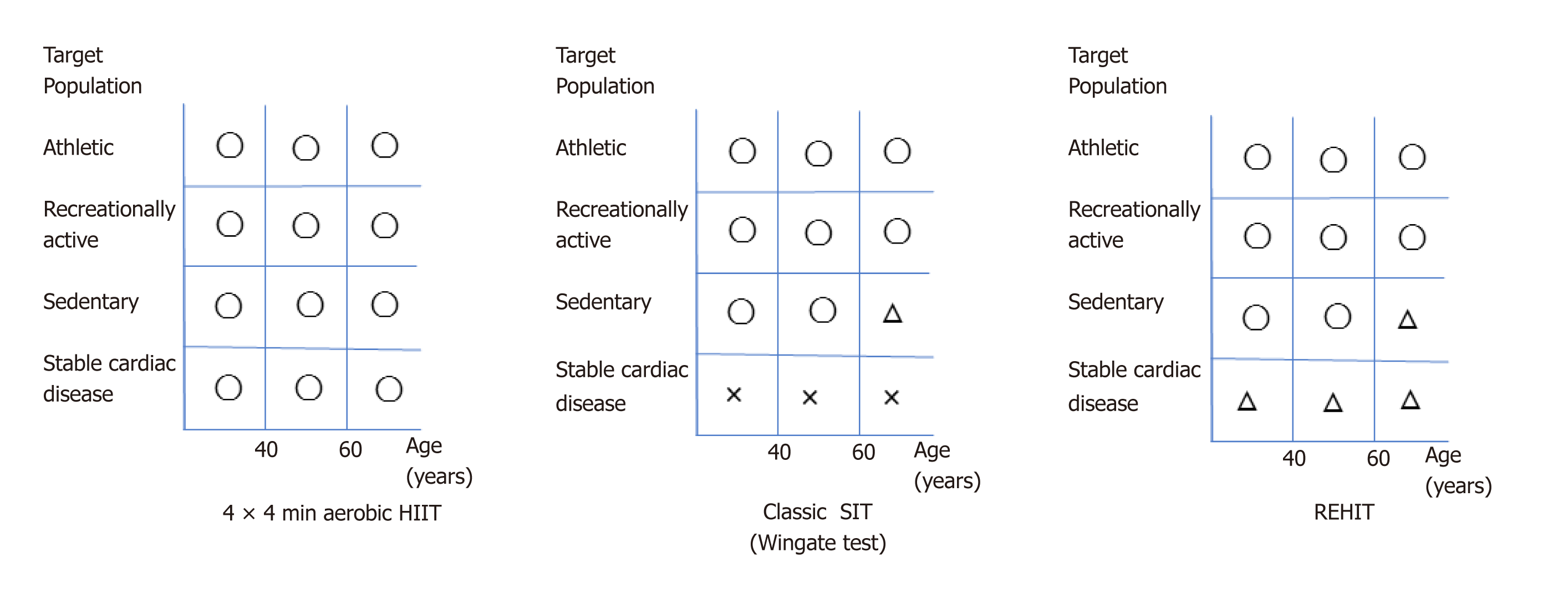Copyright
©The Author(s) 2019.
World J Cardiol. Jul 26, 2019; 11(7): 171-188
Published online Jul 26, 2019. doi: 10.4330/wjc.v11.i7.171
Published online Jul 26, 2019. doi: 10.4330/wjc.v11.i7.171
Figure 1 Schema of high-intensity interval training (HIIT) protocols.
Adapted from Ito S. EC Cardiology 6.3 (2019): 196-200. HIIT is classified into two types: submaximal aerobic HIIT and all-out anaerobic HIIT [sprint interval training (SIT)]. Reduced-exertion HIIT (REHIT) is a low-dose and shorter SIT that is modified from SIT but is still an all-out anaerobic exercise. 4 × 4 min HIIT: four 4-min intervals at 90%-95% of maximal heart rate separated by 3-min active recovery periods of moderate intensity at 60%-70% of the maximal heart rate. Classic SIT: repeated (6-8) all-out bouts at vigorous intensity ~350% of VO2peak of short duration (30 s) followed by a long complete rest (2-5 min). REHIT: 10-min cycling session at 25 W interspersed with 1 (first session) or 2 (all remaining sessions) Wingate-type cycle-sprints against a constant torque of 0.65 Nm・kg lean mass−1. Sprints last 10 s in sessions 1-4, 15 s in sessions 5-12, and 20 s in the remaining 12 sessions.
Figure 2 Graphic representation of beneficial cardiovascular and metabolic effects and relevant mechanisms activated by high-intensity interval training.
Glycolysis of glycogen granules in the skeletal muscle, catecholamine release, increased shear stress in the vessels, and increased autonomic nerve activity by HIIT are related to increased aerobic and metabolic capacities. Activity in skeletal muscle cells and arteries are increased during HIIT. The decrease in glycogen content by glycolysis results in the release of the AMP-activated protein kinase (AMPK) from the glycogen particle, resulting in greater activity and altered localization. In addition, exercise in a low-glycogen state after glycolysis leads to the phosphorylation and activation of peroxisome proliferator-activated receptor γ coactivator 1-α (PGC-1α). Finally, the osmotic stress associated with a rapid change in glycogen content and increased glucose concentration can activate mitogen-activated protein kinases (MAPKs) such as p38, which can phosphorylate and activate PGC-1. Another target of p38 is interleukin 6 (IL-6), which targets AMPK as one of the potential targets. These alterations in muscle signaling also result in improved circulating fatty acid (FA) utilization. The increased catecholamine level promotes an increase in fat metabolism by activating heat shock protein through protein kinase A. An additional cellular target of catecholamine is the cAMP response element-binding protein (CREB). HIIT can increase the phosphorylation and activation of CREB in both exercised muscle and muscles that were not recruited during the exercise due to the central effects of elevated central nervous system activity. One of the targets of CREB is PGC-1α. An increase in PGC-1α mRNA and protein with co-activation of the transcription factor results in the increase in the mRNA and protein of the mitochondrial oxygenation enzyme, and finally, improvements in physical fitness (aerobic capacity). HIIT increases cardiac output, leading to shear stress in arteries and resulting in improvements in endothelial function and pulse wave reflection potentially through endothelial microparticles.ACC: Acetyl CoA carboxylase; AMPK: AMP-activated protein kinase; CREB: cAMP response element-binding protein; HIIT: High-intensity interval training; IL-6: Interleukin 6; MAPK: Mitogen-activated protein kinases; PGC1α: Peroxisome proliferator-activated receptor γ coactivator 1-α; TF: Transcription factor.
Figure 3 Personal proposal of high-intensity interval training (HIIT) protocols for target people stratified by age, exercise habits, and cardiovascular disease.
4 × 4 min HIIT: Can be adopted for all subjects, with the intensity maintained at 85%-95% of an individual ’s peak heart rate. Classic sprint interval training (SIT): The feasibility and safety of this protocol for patients complicated with cardiovascular disease have not been evaluated. Reduced-exertion HIIT (REHIT): Its feasibility and safety for patients complicated with cardiovascular disease have not been evaluated. Because REHIT is much less strenuous than classic SIT, future research on this protocol is expected for patients with stable cardiovascular diseases besides high-risk patients, such as those with refractory hypertension and coronary heart disease with atherosclerotic plaque. O: adaptable for all target subjects; Δ: potentially adaptable for target subjects without risk; ×: should be prohibited for all target subjects.
- Citation: Ito S. High-intensity interval training for health benefits and care of cardiac diseases - The key to an efficient exercise protocol. World J Cardiol 2019; 11(7): 171-188
- URL: https://www.wjgnet.com/1949-8462/full/v11/i7/171.htm
- DOI: https://dx.doi.org/10.4330/wjc.v11.i7.171











